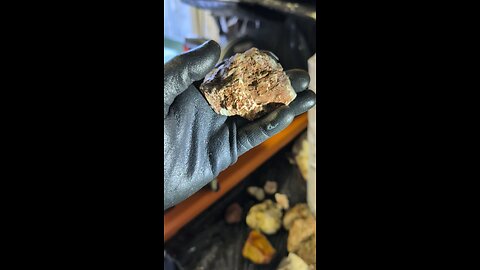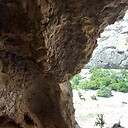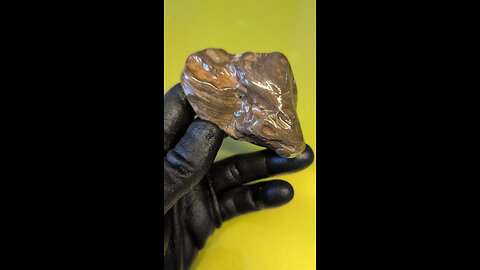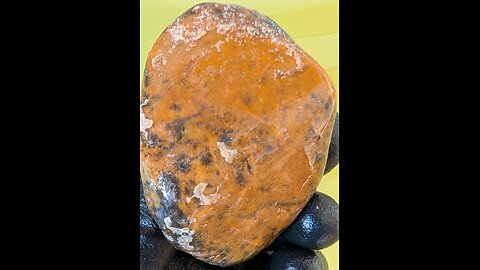
-
A river runs through it!
 HumbleConservativeBased on the image, the rock appears to have a layered structure with a mix of colors, predominantly gray with some yellowish-brown areas. This suggests it could be a type of banded iron formation or possibly a metamorphic rock like slate or schist. Banded iron formations are known for their alternating layers of iron oxides and silica or chert, while slate and schist are metamorphic rocks that can show similar banding due to the alignment of minerals under pressure and heat.55 views
HumbleConservativeBased on the image, the rock appears to have a layered structure with a mix of colors, predominantly gray with some yellowish-brown areas. This suggests it could be a type of banded iron formation or possibly a metamorphic rock like slate or schist. Banded iron formations are known for their alternating layers of iron oxides and silica or chert, while slate and schist are metamorphic rocks that can show similar banding due to the alignment of minerals under pressure and heat.55 views -
Jasper w/iron inclusions!
 HumbleConservativeJasper is a type of chalcedony, which is a microcrystalline variety of quartz. Specifically, jasper is known for its opaque appearance and often comes in various colors, primarily red, yellow, brown, or green, due to the presence of impurities like iron oxides or other minerals. Here are some key characteristics of jasper: Texture: Typically fine-grained with a smooth, sometimes waxy, surface. Hardness: On the Mohs scale, jasper ranks between 6.5 and 7, making it quite durable. Formation: Jasper forms in hydrothermal veins, volcanic rocks, or as sedimentary deposits. It can also occur in nodules or as a cementing material in conglomerates. Jasper often exhibits patterns or banding, which can be quite striking, leading to its use in jewelry, decorative items, and even in ancient artifacts for its beauty and durability. Varieties of jasper include: Picture Jasper: Known for its landscape-like patterns. Red Jasper: Often uniform in color, used for its deep red hue. Ocean Jasper: Characterized by orbicular pat42 views
HumbleConservativeJasper is a type of chalcedony, which is a microcrystalline variety of quartz. Specifically, jasper is known for its opaque appearance and often comes in various colors, primarily red, yellow, brown, or green, due to the presence of impurities like iron oxides or other minerals. Here are some key characteristics of jasper: Texture: Typically fine-grained with a smooth, sometimes waxy, surface. Hardness: On the Mohs scale, jasper ranks between 6.5 and 7, making it quite durable. Formation: Jasper forms in hydrothermal veins, volcanic rocks, or as sedimentary deposits. It can also occur in nodules or as a cementing material in conglomerates. Jasper often exhibits patterns or banding, which can be quite striking, leading to its use in jewelry, decorative items, and even in ancient artifacts for its beauty and durability. Varieties of jasper include: Picture Jasper: Known for its landscape-like patterns. Red Jasper: Often uniform in color, used for its deep red hue. Ocean Jasper: Characterized by orbicular pat42 views -
My BFFs a BIF!
 HumbleConservativeA banded iron formation (BIF) is a type of sedimentary rock characterized by alternating layers or bands of iron oxides and iron-poor chert (a type of fine-grained silica). Here's a detailed explanation: Formation: Banded iron formations are thought to have formed in ancient seas where there were significant changes in oxygen levels. They date back to the Precambrian era, particularly during the Archean and Proterozoic periods, around 2.5 to 1.8 billion years ago. The process involves the precipitation of iron and silica from seawater, which was rich in dissolved iron under the anoxic (low oxygen) conditions of the early Earth's oceans. Composition: These formations typically consist of layers of iron oxides like hematite (Fe₂O₃) or magnetite (Fe₃O₄), alternating with layers of chert. The iron layers are usually darker, while the chert layers are lighter, creating the characteristic banding. Significance: BIFs are significant for several reasons: Geological History: They provide evidence of the Earth's early oxygenation events, particularly the Great Oxidation Event, where oxygen began to accumulate in the atmosphere. Economic Importance: They are major sources of iron ore, which is crucial for steel production. The iron extracted from these formations has been vital for industrial development. Scientific Research: They offer insights into the history of Earth's climate, ocean chemistry, and the evolution of life, as the oxygenation of the atmosphere is linked to the rise of photosynthetic organisms. Appearance: Visually, banded iron formations are quite striking with their distinct banding, which can range from millimeter to meter scale. The bands often show a clear contrast in color, with reds, browns, and blacks from the iron oxides and whites or light grays from the chert. Locations: Some of the most famous and well-studied banded iron formations are found in regions like the Hamersley Range in Western Australia, the Lake Superior region in North America, and the Transvaal Supergroup in South Africa.23 views
HumbleConservativeA banded iron formation (BIF) is a type of sedimentary rock characterized by alternating layers or bands of iron oxides and iron-poor chert (a type of fine-grained silica). Here's a detailed explanation: Formation: Banded iron formations are thought to have formed in ancient seas where there were significant changes in oxygen levels. They date back to the Precambrian era, particularly during the Archean and Proterozoic periods, around 2.5 to 1.8 billion years ago. The process involves the precipitation of iron and silica from seawater, which was rich in dissolved iron under the anoxic (low oxygen) conditions of the early Earth's oceans. Composition: These formations typically consist of layers of iron oxides like hematite (Fe₂O₃) or magnetite (Fe₃O₄), alternating with layers of chert. The iron layers are usually darker, while the chert layers are lighter, creating the characteristic banding. Significance: BIFs are significant for several reasons: Geological History: They provide evidence of the Earth's early oxygenation events, particularly the Great Oxidation Event, where oxygen began to accumulate in the atmosphere. Economic Importance: They are major sources of iron ore, which is crucial for steel production. The iron extracted from these formations has been vital for industrial development. Scientific Research: They offer insights into the history of Earth's climate, ocean chemistry, and the evolution of life, as the oxygenation of the atmosphere is linked to the rise of photosynthetic organisms. Appearance: Visually, banded iron formations are quite striking with their distinct banding, which can range from millimeter to meter scale. The bands often show a clear contrast in color, with reds, browns, and blacks from the iron oxides and whites or light grays from the chert. Locations: Some of the most famous and well-studied banded iron formations are found in regions like the Hamersley Range in Western Australia, the Lake Superior region in North America, and the Transvaal Supergroup in South Africa.23 views

